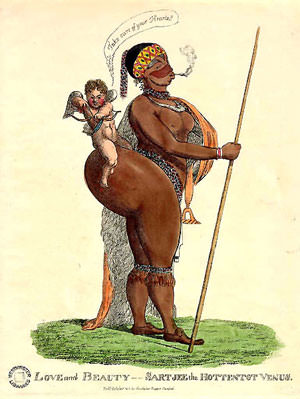AIDS and the Myth of the Oversexed Negro
Why do so many in the global health establishment insist on viewing the AIDS crisis in Africa through the lens of a 19th century stereotype?
Conventional wisdom insists that habits die hard. Stereotypes die even harder. Ever since journalist/adventurer Henry Stanley Morton’s account of Lord Napier’s 1868 Ethiopian campaign was published by The New York Herald, Africa has remained, in the minds of Americans, an ungovernable jungle where half-naked pygmies, polygamists and pagans roam around, negotiating their existence in the midst of exotic primitive chaos.
And if you think these are tales of bygone years, the Homo ancestralis thesis, which was propounded as recently as 1987 by John and Pat Caldwell, states that Africans are so distinct and different from Eurasians that they need a separate species classification apart from Homo sapiens, which would be Homo ancestralis — the ancestral man for whom life is about ancestors, lineage organization, descent, procreation and, by extension, sex.
The notion of Homo ancestralis spun the African sexuality thesis (Caldwell et al, 1989), which treats African culture as a homogenous whole and states that because Africa is fertility-oriented, morality and religion are secondary to sexual relations on the continent. Characterized by a general lack of guilt or moral codes, therefore, sex in Africa, according to these authors, is an activity like working, eating or drinking and is transacted in very much the same matter-of-fact manner.
Africa’s case has not been helped by the emergence of AIDS, and the insistence of the HIV/AIDS orthodoxy that its primary mode of transmission among Africans is heterosexual sex. To compound an already complex situation, the African green monkey hypothesis also traces the origin of AIDS to Africa. Many spirited efforts have been made to debunk the green monkey theory, but it continues to hang around like a bad smell.
It was therefore inevitable that the historically touted myth of the oversexed Africans would resurface to explain Africa’s heterosexual AIDS transmission rate. It was also inevitable that practices such as polygamy, concubinage, widow-inheritance, widow-cleansing and female circumcision would be taken out of cultural context, held up for new scrutiny and used as a standard for confirming the world’s worst fears about Africa.
Against this background, it is no major surprise that AIDS in Africa has been understood and fought along “behavior and behavioral change” lines. Sound bites from HIV/AIDS strategists and commentators confirm this.
“If you ask me why is there more AIDS in Africa and I say because Africans f— more, what’s your reaction?” — Elizabeth Pisani, epidemiologist, quoted in “Why We Are Losing the War on AIDS,” The Sunday Herald, May 4, 2008.
“AIDS would be brought under control only if Africans restrain their sexual cravings.” — Dr. Yuichi Shiokawa, speaking at the 10th International AIDS Conference, Yokohama, August 1994.
“Let me be very blunt: The heterosexual transmission of AIDS is, in Africa, a function of truly pathological promiscuity. So this is really a violence issue — not the same violence we deal with in Boston, where teenagers stab and shoot each other, but the violence of African men who are killing themselves, and killing African women and children, with pathological promiscuity.” — The Rev. Eugene Rivers, quoted in “Silence Is Death,” The Boston Review, April/May 1999.
“Sex, love and disease do not mean the same thing to Africans as they do to West Europeans [because] the notion of guilt doesn’t exist in the same way as it does in the Judeo-Christian culture of the West.” — Professor Nathan Clumeck of the Universite Libre in Brussels, quoted in Le Monde section of The Manchester Guardian Weekly, Dec. 14, 1993.
“Many men in Africa take their women in a brutal way, so that some heterosexual activity regarded as normal by them would be closer to rape by our standards and therefore be likely to cause vaginal lacerations through which the AIDS virus could gain entry into the bloodstream.” — “Reassuring News About AIDS: A Doctor Tells Why You May Not Be at Risk,” Cosmopolitan magazine, January 1988.
“Many African men prefer ‘dry sex,’ a practice whereby women, particularly prostitutes, are said to insert substances, such as household detergents or antiseptics, in their vagina prior to intercourse in order to prevent wetness. This practice allegedly produces a ‘hot, tight, and dry’ environment, which their men find more pleasurable but which may increase the risk of HIV-1 transmission, since the substances could cause the disruption of the membranes lining the vaginal and uterine wall.” — The Lancet, Oct. 17, 1998.
“In the Great Lakes area of Africa, to stimulate a man or a woman and induce them to intense sexual activity, he-monkey blood (for a man) or she-monkey blood (for a woman) was directly inoculated in the pubic area and also the thighs and back. These magic practices would therefore constitute an efficient experimental transmission model and could be responsible for the emergence of AIDS in man.” — The Lancet, June 27, 1987.
In line with the behavioral change model of HIV/AIDS prevention, a new World Bank-backed anti-AIDS experiment introduced in April 2008 will pay $45 every six months to 3,000 men and women, aged 15 to 30, in southern Tanzania over three years, on the condition that periodic laboratory test results prove they have not contracted AIDS or other sexually transmitted infections.
The program will be jointly funded by the World Bank, the William and Flora Hewlett Foundation, the Population Reference Bureau and the Spanish Impact Evaluation Fund. According to Carol Medlin of the University of California, San Francisco, who is one of the researchers working on the program, the aim of the program is to “make people think hard about the long-term consequences of their short-term behavior. The rationale is that in spite of billions of dollars spent annually on treatment and prevention worldwide, there were about 2.5m [million] new HIV infections in 2007, predominantly in Africa.”
The blogosphere (a veritable tool for checking the public’s pulse) is awash with reactions to this “innovation.” These reactions, ranging from the condescending to the pissed-off, leave Africa in the usual place — an infant continent populated by half-wits. “If safer sex is a function of income, won’t paying people for anything, without conditions, reduce their risky behavior? Why bother paying for the monitoring? Why don’t we just write the whole continent a check?” — Economic Woman
“So, if we’re all equal, why are they paying Negroes not to get AIDS? I suggest if you’re one of those people that believe this program to be a good idea, you’re the one reinforcing inequality and bigotry, not me. What next, pay American blacks not to rape and murder American whites? BTW, this program will turn out to be another absolute failure, just like every other program launched by NGOs in Africa.” — Curt Maynard’s blog
“Not to be too cold hearted, but why do we care so much? If, after being told about STDs, their effects and the likelihood of getting one, people still chose to have risky sex … why would we want to stop them? … There is probably an argument to be made that the fewer cases of AIDS in the world, the less likely I am to get it. True, but why start in Southern Tanzania? … I think most people giving the money are not likely to be there any time soon. …” — Marginal Revolution
“The main objection that resonates with me regarding the Tanzania project, backed by the World Bank, is the idea that this ‘reverse prostitution’ is the only way to reduce transmission of HIV, i.e., that we have to pay Africans to not get HIV because nothing else has worked. What a derogatory thought.” — Congo Girl
“Preach to me about race and diversity, then rant and rave about those damn blacks in Africa who just keep copulating without condoms and have unsafe sex, have multiple partners and die.” — insomnomaniac
“There are CULTURAL issues at hand that money will not fix. This has nothing to do with not trying to help black people, it has to do with realizing that no matter how many millions of our tax dollars we throw at African AIDS populations, they will continue to resist using condoms, will continue to engage in unsafe sex with multiple partners, and will continue to get sick and die.” — insomnomaniac
“Would you not agree that if we MUST have Africans coming over here in droves raping our women, it’s better that they’re not infected with the usual variety of ‘interesting’ tropical diseases? Give the World Bank a break, huh?” — Curt Maynard’s blog
Away from the blogs, the Joint United Nations Program on AIDS (UNAIDS) reports that even though sub-Saharan Africa has just over 12 percent of the world’s population, it’s home to more than 60 percent of all the people living with HIV. According to the World Bank, a “morbid equilibrium” has been reached across sub-Saharan Africa in which the number of newly infected people nearly equals the number of people dying of AIDS.
Many eminent scientists (Africans and non-Africans) have questioned UNAIDS estimates of HIV prevalence in Africa and indeed elsewhere, so let’s leave that to the scientists. However, it does not take a scientist to sense the moral of this new experiment: Africans have too much sex, with too many partners, with too little protection, and need to be saved from self-destruction.
Now, how much sex do Africans really have? Or as Eileen Stillwaggon (2001) succinctly asks, “How much sex are we talking about that would produce, in the absence of other factors, prevalence of HIV in Botswana that is over 50 times that of the United States, 80 times that of France and 1,000 times that of Cuba?”
Is this even possible? According to Richard and Rosalind Chirimuuta (1997), “In order to have one-third of the sexually active adults in some central and east African countries infected with AIDS, life in these countries must be one endless orgy.”
Possible or not, the “oversexed” explanation sticks because it fits into “what everyone knows about Africa” from the tales of early missionaries and explorers about the Dark Continent and its naked and lusty natives.
Modern studies, however, tell a different story. The Durex Global Sex Survey seems to debunk the myth of excessive sexuality of Africans. The 2007 Sexual Wellbeing Survey questioned more than 26,000 respondents (online) across 26 countries about every aspect of their sex lives. The study found that Greeks have the most sex, at 164 times a year, followed by Brazilians (145 times a year), followed by Poles and Russians (143 times a year). South Africa occupied the 11th position, with 71 percent of South Africans having sex weekly. Nigeria came in a distant 24th out of the 26 countries, with 53 percent of Nigerians having sex weekly.
The study, however, found Nigeria to be the most sexually satisfied nation, with 67 percent of Nigerians reporting sexual satisfaction. They were followed by Mexicans (63 percent), Indians (61 percent) and Poles (54 percent).
The detailed 2005 Durex Global Sex Survey paints a more comprehensive picture. Based on the number of respondents, 317,000 from 41 countries, it is hailed as the largest sexual health research project of its kind in the world. According to this study, the Greeks top the sex chart with 138 sexual episodes a year, closely followed by Croatians (134 episodes), Serbian Montenegrins (128 episodes) and Bulgarians (127 episodes).
Turks have more sexual partners than any other nationality, the report says, with 14.5 partners in a lifetime. They are followed by Australians (13.3 partners), New Zealanders (13.2 partners) and Icelanders (13 partners). New Zealand women have the highest number of sexual partners in the world, with an average of more than 20 in a lifetime, almost three times the world average. Italians reported 12 sexual partners in a lifetime, the United States and Switzerland reported 10 sexual partners, France eight and Spain six, while Malaysia, Indonesia, India, China and Hong Kong all reported between two and six sexual partners in a lifetime.The Turks also top the chart when it comes to extramarital affairs; 58 percent of Turks have extramarital affairs. The Norwegians top the “one-night stand” list, with 70 percent of Norwegians prone to one-night stands, followed by the Finns, New Zealanders and Swedes, all reporting a rate of 64 percent.
Icelanders are having sex younger than any other nationality. Their average age at first sexual experience is 15.6 years. They are followed closely by the Germans (15.9), Swedes (16.1) and Danes (16.1).
And talking about safe sex, 73 percent of Norwegians are not likely to take precautions, followed by the Greeks (70 percent) and Swedes (66 percent).
In none of these lists do Africans come out tops. The only significant mention of Africans is in the 2007 Sexual Wellbeing Report, which states that “Nigerians take the longest time over sex, at 24 minutes per session, while Indians have the quickest sex, at 13 minutes per session.”
Even then, I find this aspect of the report curious, because as a Nigerian woman over 40, I have yet to take part in this kind of “marathon.” I guess the Nigerian men who have crossed my path were “13 minutes per session” Indians in their previous lives!
To be sure I was not missing out on anything, I took the trouble of surveying friends, relations, acquaintances and every Nigerian I could contact — young, middle-aged and old. All their accounts hover around the Indian 13-minutes variety. So who are these bionic “24 minutes per session” Nigerians?
On a more serious note, empirical evidence suggests that Africans are by no means “more sexual” than the other races. A 1991 study by researchers from the French group Medicins Sans Frontieres and the Harvard School of Public Health surveyed sexual behavior in the Moyo district of northwest Uganda (one of the countries most affected by AIDS in Africa) and found that, on average, women had their first sex at age 17 and men at 19. Eighteen percent of women and 50 percent of men reported premarital sex; 1.6 percent of the women and 4.1 percent of the men had casual sex in the month preceding the study, while 2 percent of women and 15 percent of men reported premarital sex in the preceding year. Do these findings reveal anything different from what happens in Europe and America?
Indeed, many ethnographic studies point not to the hypersexuality of Africans, but to the corrupting influence of European colonialism and the loosening of traditional controls that have come with Christianization, modernization and Westernization. European missionaries ensured that Africans gave up their elaborate pagan initiation rites without considering the cultural relevance of those rites. It turns out that older members of the community gave sex and sexuality education to initiates during these rites of passage into adulthood. That traditional education has gradually been replaced by media “education” and Hollywood movies. Everyone knows what kind of influence that combination has.
For instance, writing about the Yoruba of Nigeria (West Africa), William Bascom (1969) states that, in former times, virginity was expected of the bride and was the case for 90 percent of brides. Jerry Eades (1980) also attests that among the Yoruba early in the 20th century, great importance was attached to a girl’s virginity at marriage. The author states that while virginity is less important today, it still constitutes an ideal from the male point of view.
Suzette Heald (1995) also argues that Caldwell’s African sexuality thesis (1989) fails to grasp the way sexual restraints and restrictions form the basis of the moral order in East African societies. In her work with East African cultures, she found that sacred power was and still is attributed to coitus as a life-creating force. She also found evidence of extreme reticence and restriction in the actual conduct of sexuality. According to the author, there was a preoccupation with the control of sexuality, so that the controls surrounding sex, and the self-control that one must exercise with regard to it, epitomized social and moral behavior. She reports that coitus, among these cultures, was fraught with danger, circumscribed by taboo and subject to restrictions unknown in the West.
Heald attests further that, just as conjugal sexuality was subject to restriction in many East African societies, so too it appears that the issue of premarital chastity was not taken lightly. Prestige and value were attached to the virgin bride. Extra bridewealth was paid and cattle were slaughtered in the virgin bride’s honor, and there was corresponding shame for the non-virgin bride.
Hugo Lambert (1956) also asserts that among the Meru (East Africa), “customary opportunities for intercourse were in fact reduced in native life to a rarity which the European would certainly find irksome.” Lambert, a British administrator, was commissioner of the Meru district for many years.
Jane Chege (1993) found that among the Meru, coitus was a central religious act, the medium for the reception of blessings or to seal a curse. Sexual relations were regulated by an elaborate series of prohibitions, which determined permissible partners, places and times.
According to Thabisile Buthelezi (2006), the Zulu communities of South Africa emphasized abstinence before marriage. To promote this, some communities in KwaZulu-Natal practiced virginity testing among some girls.
Charles Geshekter (1994) attests that the Somalis, Afars, Oromos and Amharas of northeast Africa think that public displays of sexual feelings demean a woman’s “gift,” so that sexual contacts are restricted to ceremonial touching or dancing. Initial sexual relationships among these ethnic groups are geared to the beginnings of making a family. He also reports that the notion of “boyfriends” and “girlfriends,” virtually universal in the West, has no parallel in most traditional African cultures.
To present an exhaustive catalog of the different sexual habits found across Africa would be impossible in this article. While these traditional habits may have been considerably eroded by modernization, they remain the standard and are still rewarded and celebrated. For the curious, an ethnographic index of sexual practices in sub-Saharan Africa can be found in Janssen’s “Growing Up Sexually in Sub-Saharan Africa” (2002).These ethnographic accounts bear no semblance to what was widely touted as the degenerate sexuality of the Negro, and which came to define American understanding of black sexuality.
“Every unphysiologic and antisocial act that tends to breed degenerate human beings, sinful, vicious, and lustful, lies inherent in the African. He will walk the alleys at night with a penis swollen from disease, and infect his bride-to-be with the same nonchalance that he will an hour later exhibit when cohabiting with the lowest of his race” — W. L. Howard, “The Negro as a Distinct Ethnic Factor in Civilization,” Medicine 9, Page 425. 1903).
“When we take into consideration the ancestry of the American Negro, and reflect upon the peculiar sexual relations sustained by that ancestry, it is by no means surprising that ancestral traits crop out occasionally. Marriage among certain Negro tribes is as close a simulation of what is designated as rape in civilized communities as could well be imagined. When the Ashantee warrior knocks down his prospective bride with a club and drags her off into the woods, he presents an excellent prototype illustration of the criminal sexual acts of the Negro in the United States.” — G.F. Lydston and H. McGuire, “Sexual Crimes Among the Southern Negroes,” Renz and Henry, Publishers, Page 7. 1893.
Frantz Fanon (1952) was so peeved by the fact that black sexuality was “the subject of a widespread fantasy, which fixates the black man at the level of the genitals,” that he declared, “One is no longer aware of the Negro, but only of a penis; the Negro is eclipsed. He is turned into a penis.”
And in case you think Fanon was taking things a bit too far, he attests that French writer Michael Cournot wrote, “Four Negroes with their penises exposed would fill a cathedral.”
What was Cournot thinking? To quote Stuart Hall (2003), “Is this a joke in bad taste, or does it have a deeper meaning?”
It obviously had and still has a deeper meaning. The myth of the oversexed Negro is alive and well. It relentlessly resonates at the highest professional levels and seems to blight HIV/AIDS interventions in Africa.
Fortunately, there are still some people who are capable of looking at things in a different way. Eileen Stillwagon — a health and development economist who has worked in Tanzania and Zimbabwe — in her “Racial Metaphors: Interpreting AIDS and Sex in Africa,” finds similarities in the U.S. for many of the behaviors for which Africans are condemned.
Scenario 1: In Uganda, Zeinab, 30, runs a lodge. She has a male companion who contributes to her household, but she does not see this as a permanent relationship. In the U.S., Cathy, 30, works for an editorial house in Manhattan. She has a live-in boyfriend but does not think they will get married.
Question: How is Zeinab different from Cathy?
Scenario 2: In Africa, some young women depend on “sugar daddies,” older men who pamper them with cash and gifts in exchange for sex. In the U.S., the July 2002 edition of the beauty magazine Allure, which is marketed to teenagers and young women, ran a feature article entitled “Tricks for Treats.” The article gave instructions for securing expensive gifts from wealthy men through sex.
Question: If the African example means that transactional sex is the norm in Africa, does the Allure article (with the magazine’s monthly circulation of 1 million) indicate that transactional sex is the norm in the United States?
Scenario 3: In Africa, masculine sexual ideology revolves around the notion that men must have many sexual partners to be satisfied. In the U.S., a beer commercial shows the numbers on an odometer spinning in a man’s mind as he tries to count his previous sexual contacts. The American blues song, “You Got to Have More Than One Woman (if You’re Gonna Get Along),” recorded by Tim Hardin in 1967, was very well received. Additionally, a white male participant (in his 30s) in a March 2008 edition of Fox’s “Moment of Truth” admitted that he had had sex with more than 100 women.
Question: How is the American male ideology different from the African male ideology?
And if you are one of those who believe that “condom use and a pattern of serial sexual partners” differentiates sexual relations in the U.S. from Africa’s purported “unprotected sex with multiple, concurrent sexual partners,” you need to watch “The Maury Show” now and then. This show never runs out of paternity sagas. More often than not, the “accused” man is vindicated by the results of a DNA test, and the woman (black, white or Latina) continues the shameful quest for her “baby-daddy.” One woman recently brought 34 men to the show for DNA tests to determine the paternity of her four children. The sagely Judge Glenda Hatchett also devotes many episodes of her televised court to resolving sensational paternity disputes. These are not great exemplars of U.S. monogamous sex or condom use!
Stillwaggon concludes that anyone looking for limitless, multipartnered sex will find data in sub-Saharan Africa, just as any foreign censor looking for American decadence will find ample evidence in American advertising, movies, magazines, music or, indeed, sexual behavior. Besides, as Gunnar Myrdal (1944) observed, cultural influences pose the questions we ask, influence the facts we seek and determine the interpretation we give these facts.
The business of this article is not to deny that AIDS is a problem in Africa. Those who have the expertise to question Africa’s HIV figures are already doing so. Whether AIDS is an epidemic or even a pandemic in Africa, however, characterizing a whole race as “sex-mad fiends,” is not the way to contain it. That will simply bleed old wounds, fan distrust and undermine genuine prevention efforts.
It’s time to stop singing the “pan-African hypersexuality” song and start looking at other factors that may be driving HIV in Africa, such as poverty and the risks that poverty creates — malnutrition, low immunity, stress, poor sanitation, overcrowding, poor access to health care, substandard health care, rural deprivation and urban squalor — all of which will facilitate the spread of AIDS or, indeed, any other disease.
Related Articles
John C. Caldwell, Pat Caldwell and Pat Quiggin (1989), “The Social Context of AIDS in Sub-Saharan Africa.”
Andrew Jack (2008), “World Bank Backs anti-Aids Experiment” (Financial Times, April, 25).
Suzette Heald (1995), “The Power of Sex: Some Reflections on the Caldwells’ ‘African Sexuality’ Thesis.”
Beth Maina Ahlberg (1994), “Is There a Distinct African Sexuality? A Critical Response to Caldwell.”
Eileen Stillwaggon (2001), “AIDS and poverty in Africa.”
Eileen Stillwaggon (2003), “Racial Metaphors: Interpreting Sex and AIDS in Africa.”
Charles Geshekter (1999), “A Critical Reappraisal of African AIDS Research and Western Sexual Stereotypes.”
Stuart Hall (2003), “The spectacle of the ‘Other.’ “
Marie-Nathalie Le Blanc, Deidre Meintel and Victor Piche (1991). “The African Sexual System: Comment on Caldwell et al.”
Thabisile Buthelezi (2006), “The One Who Has Eaten It, Has Only Eaten a Part: Exploring Traditional Zulu Premarital Sexual Practices.”
Sydney Bryn Austin (1990), “AIDS and Africa: United States Media and Racist Fantasy.”
Rosalind Harrison-Chirimuuta (1997), “AIDS and Africa: A Case of Racism vs. Science?”
Your support matters…Independent journalism is under threat and overshadowed by heavily funded mainstream media.
You can help level the playing field. Become a member.
Your tax-deductible contribution keeps us digging beneath the headlines to give you thought-provoking, investigative reporting and analysis that unearths what's really happening- without compromise.
Give today to support our courageous, independent journalists.






You need to be a supporter to comment.
There are currently no responses to this article.
Be the first to respond.